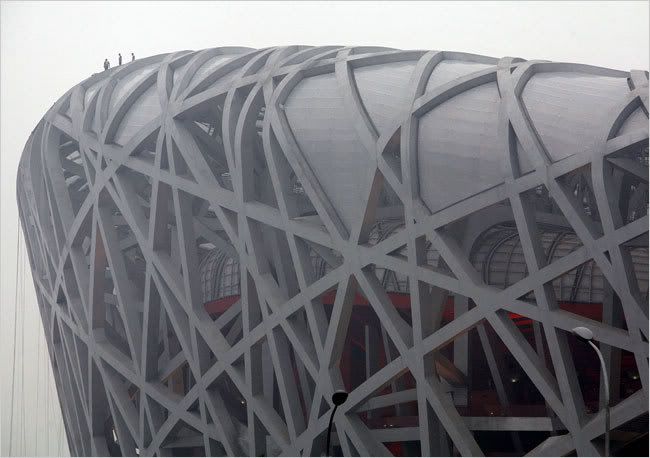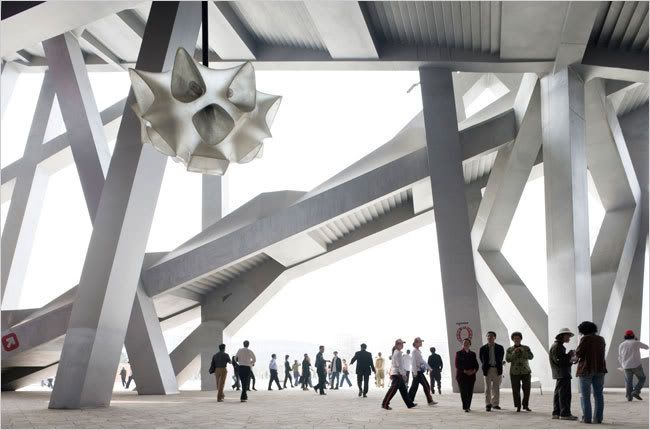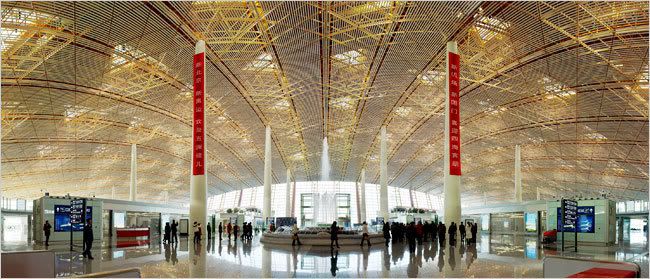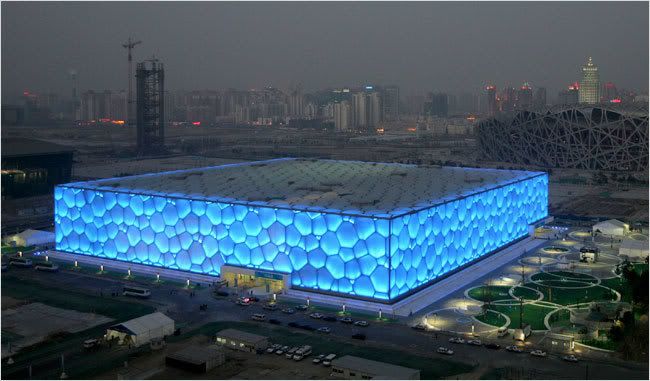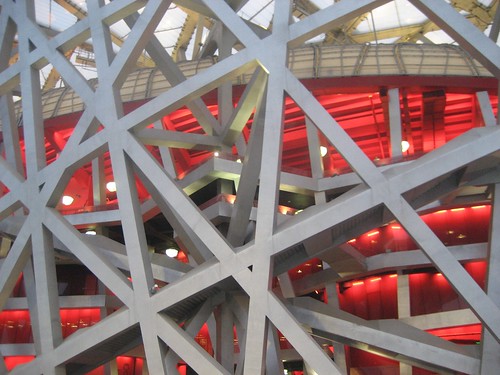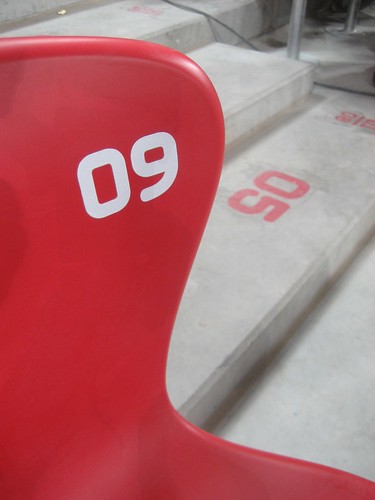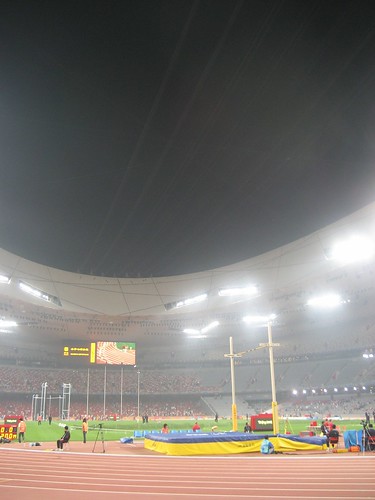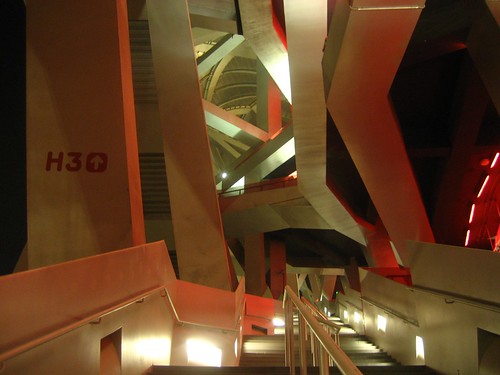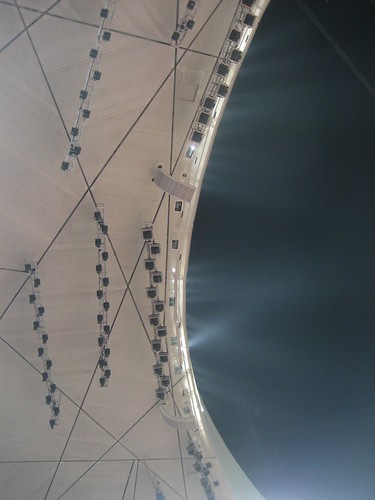wyliepoon
Senior Member
Star
http://www.thestar.com/Sports/article/415157
Beijing unveils Bird's Nest
Olympic stadium to host first event on Friday and Saturday
Apr 16, 2008 02:59 PM
ASSOCIATED PRESS
BEIJING–The centrepiece of the Beijing Olympics rises 230 feet tall, its lattice of steel beams sometimes vanishing in a thick blanket of smog.
Quietly and without fanfare, officials have opened the National Stadium – nicknamed the "Bird's Nest" – and it's ready to hatch its first sports event.
The final touches on the $450 million, 91,000-seat stadium won't be completed until next month, but organizers let journalists in Wednesday to look around.
Inside, Franco Destefanis of Italy knelt as he installed the last few slabs of the rubberized running surface for track events.
"The design, the new-style architecture and the size is impressive," said Destefanis, who has worked on 150 stadiums around the world and is doing his fifth straight Olympic track and field venue. "The outside catches your eye, particularly with the lights at night.''
Its unusual design was created by twisted steel beams that wrap around the exterior to resemble silver twigs binding a nest together. The icon of the Beijing Games, it's been called the best work produced by Switzerland-based architects Jacques Herzog and Pierre de Meuron.
However, Chinese artist Ai Weiwei, who was a consultant on the project, has since criticized it. He has likened the stadium to a ``fake smile," designed to hide social and political problems in China, which hopes to use the Olympics to show off its new political and economic power.
Of China's 37 Olympic venues, the stadium is the last to be completed. There have been minor delays, although organizers have denied construction problems. They have said that preparing for the Aug. 8 opening ceremony has required adjustments to building schedules, pushing back the stadium's completion by a few months.
Officials confirmed three months ago that two workers died during construction on the stadium, but denied media reports that at least 10 had died.
In addition to the opening ceremony, the stadium hosts track and field events and the closing ceremony.
The first event at the stadium will be on Friday and Saturday – a low-key race-walking meet. No glitzy ceremonies, political speeches or fireworks are scheduled.
On the inside, the fancy exterior lattice work is hidden from view. The roof that partially extends over many of the seats is covered with a canvas-like material that will keep rain off most fans. It also blocks strong sunlight from casting shadows on the field that could ruin TV pictures.
The stadium's indoor color scheme is red, gray and black. There was no sign of where the Olympic cauldron will be located.
From the outside, the size of the stadium overwhelms everything else, even the neighbouring swimming venue, known as the "Water Cube.''
Police have cracked down on cars stopping on the shoulder of a nearby highway to snap photos of the stadium. Curious pedestrians still line a 12-foot-high wire fence to have a look.
"When I first saw the stadium, I didn't know what it was,'' said Duan Jingxuan, leaning a shoulder on the handle of his shovel as he landscaped a small pine grove bordering a pond just east of the site.
Like thousands of migrant workers who have come to Beijing to build Olympic venues, Duan earns about $150 monthly and sends most of it home to his family in central China.
"As soon as I found out what it was, I wanted to know what it cost," Duan added. "I called my son right away – he's working at an oil field – and told him I was doing work for the Olympics. I'm proud to work here and it shows China is getting richer.''
As organizers opened the stadium to journalists on Wednesday, a thick haze of pollution made it nearly invisible from a half-mile away.
Officials say strict pollution controls will begin no later than July 20. This means closing cement factories and foundries, and halting work at hundreds of building projects. Plans are also afoot to ban about half of Beijing's 3.3 million vehicles.
The International Olympic Committee has said it will postpone outdoor endurance events if air quality is poor, and IOC President Jacques Rogge has acknowledged that athletes' performances might be ``slightly reduced" because of the pollution.
In the last month, the image of the Beijing Olympics have been sullied by protests along the torch relay route as pro-Tibet and human-rights demonstrators have focused world attention on China's policies.
Protesters are also expected to stage demonstrations during the games, testing China's ability to portray itself as a modern, sophisticated nation, despite spending an estimated $40 billion to remake the capital.
But organizers such as Liang Gang, the deputy press manager for the venue, are confident everything will fall into place once the games begin.
"Here in the stadium, they (the athletes) will concentrate on the competition, on the basic things of sports, and not the other things," he said.



*****
After all the hype over how unique this stadium will look and feel, I'm quite surprised and kind of disappointed to see that the stadium interior looks just like any other "cookie-cutter" stadium. Another case of "don't judge a book by its cover".
http://www.thestar.com/Sports/article/415157
Beijing unveils Bird's Nest
Olympic stadium to host first event on Friday and Saturday
Apr 16, 2008 02:59 PM
ASSOCIATED PRESS
BEIJING–The centrepiece of the Beijing Olympics rises 230 feet tall, its lattice of steel beams sometimes vanishing in a thick blanket of smog.
Quietly and without fanfare, officials have opened the National Stadium – nicknamed the "Bird's Nest" – and it's ready to hatch its first sports event.
The final touches on the $450 million, 91,000-seat stadium won't be completed until next month, but organizers let journalists in Wednesday to look around.
Inside, Franco Destefanis of Italy knelt as he installed the last few slabs of the rubberized running surface for track events.
"The design, the new-style architecture and the size is impressive," said Destefanis, who has worked on 150 stadiums around the world and is doing his fifth straight Olympic track and field venue. "The outside catches your eye, particularly with the lights at night.''
Its unusual design was created by twisted steel beams that wrap around the exterior to resemble silver twigs binding a nest together. The icon of the Beijing Games, it's been called the best work produced by Switzerland-based architects Jacques Herzog and Pierre de Meuron.
However, Chinese artist Ai Weiwei, who was a consultant on the project, has since criticized it. He has likened the stadium to a ``fake smile," designed to hide social and political problems in China, which hopes to use the Olympics to show off its new political and economic power.
Of China's 37 Olympic venues, the stadium is the last to be completed. There have been minor delays, although organizers have denied construction problems. They have said that preparing for the Aug. 8 opening ceremony has required adjustments to building schedules, pushing back the stadium's completion by a few months.
Officials confirmed three months ago that two workers died during construction on the stadium, but denied media reports that at least 10 had died.
In addition to the opening ceremony, the stadium hosts track and field events and the closing ceremony.
The first event at the stadium will be on Friday and Saturday – a low-key race-walking meet. No glitzy ceremonies, political speeches or fireworks are scheduled.
On the inside, the fancy exterior lattice work is hidden from view. The roof that partially extends over many of the seats is covered with a canvas-like material that will keep rain off most fans. It also blocks strong sunlight from casting shadows on the field that could ruin TV pictures.
The stadium's indoor color scheme is red, gray and black. There was no sign of where the Olympic cauldron will be located.
From the outside, the size of the stadium overwhelms everything else, even the neighbouring swimming venue, known as the "Water Cube.''
Police have cracked down on cars stopping on the shoulder of a nearby highway to snap photos of the stadium. Curious pedestrians still line a 12-foot-high wire fence to have a look.
"When I first saw the stadium, I didn't know what it was,'' said Duan Jingxuan, leaning a shoulder on the handle of his shovel as he landscaped a small pine grove bordering a pond just east of the site.
Like thousands of migrant workers who have come to Beijing to build Olympic venues, Duan earns about $150 monthly and sends most of it home to his family in central China.
"As soon as I found out what it was, I wanted to know what it cost," Duan added. "I called my son right away – he's working at an oil field – and told him I was doing work for the Olympics. I'm proud to work here and it shows China is getting richer.''
As organizers opened the stadium to journalists on Wednesday, a thick haze of pollution made it nearly invisible from a half-mile away.
Officials say strict pollution controls will begin no later than July 20. This means closing cement factories and foundries, and halting work at hundreds of building projects. Plans are also afoot to ban about half of Beijing's 3.3 million vehicles.
The International Olympic Committee has said it will postpone outdoor endurance events if air quality is poor, and IOC President Jacques Rogge has acknowledged that athletes' performances might be ``slightly reduced" because of the pollution.
In the last month, the image of the Beijing Olympics have been sullied by protests along the torch relay route as pro-Tibet and human-rights demonstrators have focused world attention on China's policies.
Protesters are also expected to stage demonstrations during the games, testing China's ability to portray itself as a modern, sophisticated nation, despite spending an estimated $40 billion to remake the capital.
But organizers such as Liang Gang, the deputy press manager for the venue, are confident everything will fall into place once the games begin.
"Here in the stadium, they (the athletes) will concentrate on the competition, on the basic things of sports, and not the other things," he said.



*****
After all the hype over how unique this stadium will look and feel, I'm quite surprised and kind of disappointed to see that the stadium interior looks just like any other "cookie-cutter" stadium. Another case of "don't judge a book by its cover".





